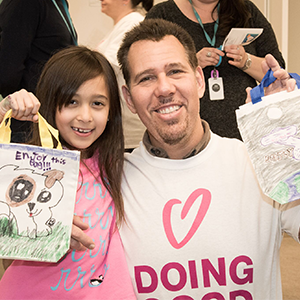Want to know the secret to a kinder, more compassionate world? Start
setting the example when your children are young. To instill a sense of
empathy, you can engage in volunteerism as a family to role model a
generosity of spirit, time and materials. Children often learn these in
school, but as a family, you can take these lessons outside of the
classroom. The upcoming Martin Luther King, Jr. National Day of Service is
a great place to start.
Here are some tips on how to make the most of your family volunteer
project, avoid common mistakes and help your child gain lifelong compassion
and an understanding of human dignity.
Finding the Project
When choosing what volunteer project to do with your child, try to think
about issues that reflect your family values and interests. Families that
love to cook can work to end hunger. Families that enjoy the outdoors can
clean up a park. Your child will get more from the project if they can
personally appreciate what they’re helping to do.
While many nonprofits host volunteers at their locations, some parents
choose to create volunteer projects independently at their homes or at
local community centers. If you choose to do something like this (making
blankets for seniors or sandwiches for a shelter), be sure to research the
needs of the recipients fully. The best of intentions can sometimes lead to
problems. For example, sometimes PB&J sandwiches get dropped off at
shelters that don’t have storage for them, and so they go to waste. Check
the recipient organization’s “How to Help” page, and do your research
before you start!
Preparing for the Project
Once you have your project, have a conversation with your child about what
you’ll be doing and why. A good way to start is by asking your child how
much he knows about the issue already. From there, you can lead a more
age-appropriate conversation with him. When he has questions, you can look
up the answers together.
When discussing the issue, talk about the root of the problem first, but
then focus on what he can do personally to help. It can be scary to hear
about a big problem with no solution, so be sure to focus on how small
things can make a big difference, and that he has the power to help.
When speaking about the issues, try to use words that put people first. For
example, instead of “helping the homeless,” say “helping people
experiencing homelessness.” This helps to explain that being homeless is a
situation, not a type of person, and shows that the project will be helping
a person, not an “issue.”
Enhancing the Project
Be sure to focus on quality over quantity. For example, if you are shopping
for a coat to donate at a coat drive, encourage your child to try on the
coat and make sure it is warm enough. Even if he can get two less-expensive
coats for the price of one, remind him that if the coat does not keep the
person warm, it is not helpful. Trying on the coat will also help him
imagine the person being helped.
While you may feel tempted to have your child witness poverty to “see how
good he has it,” remember it is not the responsibility of the people you
serve to teach your child that he is lucky.
Try to level the playing field when the project is going on to help enhance
your child’s empathy. Do things that help him understand that those being
served are just like him. For example, after a snack bag-making event for
an after-school program, the event organizers had the children who
volunteered each take and eat a snack bag they made. This helped them
understand that the children they were helping were similar to them and
reinforced the need for quality-control. We want volunteers to put the same
care in making something for a stranger as they would for a family member.
After the Project
Discuss the experience as a family, sharing your own reflections, too. Ask
about how your child felt after the project, what surprised him and what
positive elements and challenges will be remembered about the experience.
Consider encouraging your child to start a Gratitude Journal, entering
something he is grateful for every day or week. You can start a habit of
doing it in the mornings or before bedtime, and include an entry after
engaging in volunteering.
Books are also a great resource for children to further understand issues
and gain a sense of compassion. They can emotionally respond to characters
and learn more about the effect issues have on them. For volunteering book
lists by topic, check out doinggoodtogether.org/bhf/read-together.
Encourage children to do volunteer projects on their own or with their
friends. Empowering them to take action will teach them leadership skills
and possibly a lifelong interest in helping people.
For great volunteer projects to do with your kids on MLK Day and beyond,
check out jconnect.org/Doing-Good. And for even more guidance on ensuring
your children get the most out of community service, check out these
helpful guides: bit.ly/DoingGoodGuide.


